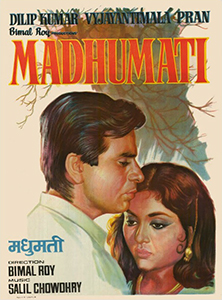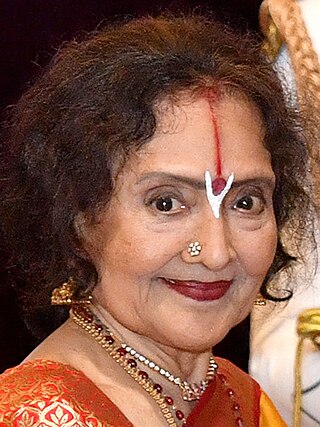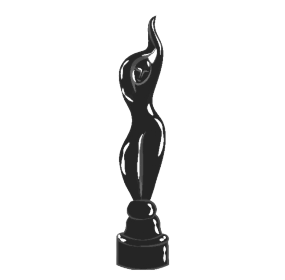| 6th Filmfare Awards | |
|---|---|
| Date | 10 May 1959 |
| Site | Bombay |
| Hosted by | J. C. Jain |
| Highlights | |
| Best Film | Madhumati |
| Best Actor | Dev Anand for Kala Pani |
| Best Actress | Vyjayanthimala for Sadhna |
| Most awards | Madhumati (9) |
| Most nominations | Madhumati (12) |
The 6th Filmfare Awards were held in 10 May 1959, at Bombay, honoring the best films in Hindi Cinema for the year 1958. [1] [2] [3]
Madhumati led the ceremony with 12 nominations, followed by Sadhna with 6 nominations and Yahudi with 5 nominations.
Madhumati won 9 awards – a record at the time – including Best Film, Best Director (for Bimal Roy) and Best Supporting Actor (for Johnny Walker), thus becoming the most-awarded film at the ceremony.
The ceremony was also noted as Vyjayanthimala became the first actress to receive dual nominations for Best Actress for her performances in Madhumati and Sadhna, winning for the latter.
| Best Editing | Best Cinematography |
|---|---|
| |
| Best Art Direction | Best Sound Design |
|
The following films had multiple wins and/or nominations
| Movie | Awards | Nominations |
|---|---|---|
| Madhumati | 9 | 12 |
| Sadhna | 2 | 6 |
| Kala Pani | 2 | |
| Yahudi | 1 | 5 |
| Talaaq | 0 | 3 |
| Phir Subha Hogi | 2 |

Nutan Samarth Bahl, known mononymously as Nutan, was an Indian actress who worked primarily in Hindi films. In a career spanning nearly four decades, she appeared in more than 80 films, that ranged in genre from urban romances to socio-realist dramas. Regarded as one of the finest actors in the history of Indian cinema, Nutan was noted for her naturalistic acting style in parts of conflicted women often deemed unconventional. Her accolades include a record five Filmfare Awards for Best Actress. In 1974, Nutan received the Padma Shri, India's fourth highest civilian award.
The Filmfare Awards are annual awards that honour artistic and technical excellence in the Hindi-language film industry of India. The Filmfare ceremony is one of the most famous film events in India. The awards were introduced by the Filmfare magazine of The Times Group in 1954, the same year as the National Film Awards. They were initially referred to as the "Clare Awards" or "The Clares" after Clare Mendonça, the editor of The Times of India and modelled after the Academy Awards.

Bimal Roy was an Indian film director. He is particularly noted for his realistic and socialistic films such as Do Bigha Zamin, Parineeta, Biraj Bahu, Devdas, Madhumati, Sujata, Parakh and Bandini, making him an important director of Hindi cinema. Inspired by Italian neo-realistic cinema, he made Do Bigha Zamin after watching Vittorio De Sica's Bicycle Thieves (1948). His work is particularly known for his mise en scène which he employed to portray realism. He won a number of awards throughout his career, including eleven Filmfare Awards, two National Film Awards, and the International Prize of the Cannes Film Festival. Madhumati won 9 Filmfare Awards in 1958, a record held for 37 years.

Badruddin Jamaluddin Kazi, professionally and popularly known as Johnny Walker, was an Indian actor and comedian who acted in around 300 films. He was best known for his humorous roles in Indian films, notably being typecast as a hapless drunkard.

Madhumati is a 1958 Indian Hindi-language paranormal romance film directed and produced by Bimal Roy, and written by Ritwik Ghatak and Rajinder Singh Bedi. The film stars Vyjayanthimala and Dilip Kumar in lead roles, with Pran and Johnny Walker in supporting roles. The plot focuses on Anand, a modern man who falls in love with a tribal woman named Madhumati. But they face challenges in their relationship finally leading to a paranormal consequence. The film was ranked 11th in the Outlook Magazine's 25 leading Indian directors' poll for selecting Bollywood's greatest films in 2003.

Vyjayanthimala is an Indian actress, dancer and parliamentarian. Regarded as one of Indian cinema's finest actresses and dancers, she is the recipient of several accolades, including five Filmfare Awards and two BFJA Awards. She made her screen debut at the age of 16 with the Tamil film Vaazhkai (1949), and followed this with a role in the Telugu film Jeevitham (1950). Her first work in Hindi cinema was the social guidance film Bahar (1951), which she headlined, and achieved her breakthrough with the romance Nagin (1954).
The 12th Filmfare Awards were held in 1965.
The 11th Filmfare Awards were held in 1964, honoring the best films in Hindi Cinema in 1963.

Vyjayanthimala is an Indian actress, Bharathanatyam dancer, Carnatic singer, dance choreographer and parliamentarian. She was the highest-paid actress of her time. Regarded as the "first female superstar" and "Megastar" of Indian cinema, She made her debut in the Tamil language film at the age of 16 with Vaazhkai in 1949 and in the Telugu film Jeevitham in 1950. She later became one of the most prominent actresses of South Indian cinema and in the golden era of Bollywood and was known as one of the iconic leading actresses of all time. Vyjayanthimala acted in Bollywood movies Bahar and Ladki. Following the success of Nagin, Vyjayanthimala established herself as one of Bollywood's leading actresses while making inroads in successful Tamil and Telugu films. After successfully establishing herself as a commercial actress, Vyjayanthimala appeared in Devdas, playing Chandramukhi, the hooker with a heart of gold, in 1955. In her first dramatic role, she received her first Filmfare Award for Best Supporting Actress at the 4th Filmfare Awards, where she refused to accept the award citing that hers was not a supporting role, being the first person to refuse a Filmfare Award. Following that, Vyjayanthimala appeared in series of blockbuster films such as New Delhi, Naya Daur and Aasha. She reached the pinnacle of her success in 1958 when two of her films — Sadhna and Madhumati — became huge critical and commercial hits. She was nominated for two Filmfare Award for Best Actress Award for Sadhna and Madhumati and won the award for the former. At this point, Vyjayanthimala made comeback to Tamil films, where she tasted commercial success with Vanjikottai Vaaliban, Irumbu Thirai, Baghdad Thirudan and Then Nilavu. In 1961, the release of Dilip Kumar's Ganga Jumna saw her playing a rustic village belle, Dhanno, who speaks the Awadhi dialect. Critics applauded her performance, while some labeled it her best to date. She won her second Filmfare Award for Best Actress for her role in Ganga Jumna. Beginning in 1962, most of her films performed either averagely or poorly at the box office. However, in 1964, with the success of Sangam, her career hit its peak again. She reinvented herself by playing a modern Indian girl appearing in revealing costumes and a one-piece swimsuit. She went to receive her third Best Actress Award at the 12th Filmfare Awards for her role as Radha in Sangam. She later achieved critical acclaim for her performance in the historical drama Amrapali, which was based on the life of Nagarvadhu, royal courtesan of Vaishali, Amrapali. The film received universal acclaim, but it was a huge box office failure, which left Vyjayanthimala, who had huge expectations of the film, disenchanted to the point where she decided to quit films. In the end of her career Vyjayanthimala was mostly seen in commercially successful films such as Suraj, Jewel Thief and Prince with a few critically acclaimed films such as Hatey Bazarey and Sunghursh. Most of them were released after Vyjayanthimala left the film industry.

Chandramukhi is one of the pivotal characters in the 1917 Bengali novel Devdas by Sarat Chandra Chattopadhyay. Her character was inspired by the Hindu mystical singer Meera, who devoted her life to Lord Krishna; similarly Chandramukhi devoted her life to Devdas. Chandramukhi is portrayed as a tawaif in the novel and its film adaptations. Chandramukhi means "moon faced" or "as beautiful as the moon" in Sanskrit.
The 9th Filmfare Awards were held on 20 May 1962, at Bombay, honoring the best films in Hindi Cinema in 1961.
The 4th Filmfare Awards were held on 5 May 1957, in Bombay, honoring the best films in Hindi cinema for the year 1956.
The 8th Filmfare Awards were held in Bombay to honor the best films in Hindi cinema in 1961.

The 1st Filmfare Awards were held on 21 March 1954, honoring the best in Hindi cinema in 1953.
Sudhendu Roy (1921–1999) was a noted Indian film director, art director and production designer in Hindi cinema, most known for his realistic art direction in auteur Bimal Roy's films, like Sujata (1959), Madhumati (1959) and Bandini (1963), and glitzy work in films Subhash Ghai's Karz (1980) and Karma (1986) to Yash Chopra's Silsila (1981), Chandni (1989) and Lamhe (1991). He won the Filmfare Award for Best Art Direction thrice for, Madhumati (1959), Mere Mehboob (1964) and Sagina (1975).
The 2nd Filmfare Awards were held in 1955.
The 3rd Filmfare Awards were held in 1956.
The 7th Filmfare Awards were held in 1960.

The Filmfare Marathi Awards are presented annually to both artistic and technical excellence of professionals in the Marathi film industry of India. The ceremony had been sponsored by various private organisations in the past as well as in present provisions. During several years in 1990s, a live ceremony was broadcast to television audiences but was later discontinued due to unknown reasons. In 1963 the awards were extended to Marathi, Tamil, Telugu and Bengali languages. The presentation of the awards has been inconsistent throughout its inception. Presently, a recorded and edited version of the awards ceremony is televised.

Mukhram Sharma was an Indian film lyricist, script, and story writer. He is best known for winning the first Filmfare Award in the Best Story category in 1955 for the film Aulad. His notable works as story writer include Vachan (1955), Sadhna (1958), Talaq (1958) and Dhool Ka Phool (1959). He also produced films like Talaq (1958), Santaan, and Diwana (1967).